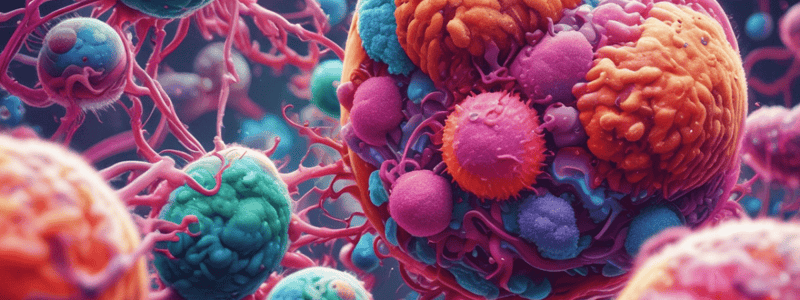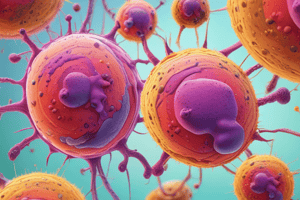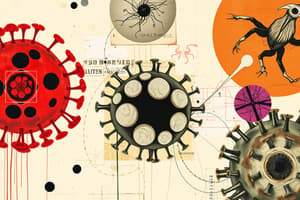Podcast
Questions and Answers
What is the defining characteristic that distinguishes pathogenicity from virulence?
What is the defining characteristic that distinguishes pathogenicity from virulence?
- Pathogenicity is the ability of a microbe to enter a host, while virulence is the ability to evade the host's immune system.
- Pathogenicity is a qualitative measure, while virulence is a quantitative measure of a pathogen's ability to cause disease.
- Pathogenicity refers to the overall potential to cause disease, while virulence describes the specific mechanisms used to cause harm.
- Pathogenicity is the ability to cause disease, while virulence is the severity of the disease caused. (correct)
Which of the following is NOT considered a typical virulence factor for microbes?
Which of the following is NOT considered a typical virulence factor for microbes?
- Capsules
- Nutrient acquisition mechanisms (correct)
- Toxins
- Antigenic variation
A pathogen with a low ID$_{50}$ value is considered to have which of the following properties?
A pathogen with a low ID$_{50}$ value is considered to have which of the following properties?
- High infectiousness (correct)
- High virulence
- Low infectiousness
- Low virulence
Which of the following is the preferred portal of entry for the development of anthrax disease caused by $Bacillus$ $anthracis$?
Which of the following is the preferred portal of entry for the development of anthrax disease caused by $Bacillus$ $anthracis$?
How does the concept of virulence differ from the concept of pathogenicity?
How does the concept of virulence differ from the concept of pathogenicity?
Which of the following is NOT considered a typical portal of entry for microbial pathogens?
Which of the following is NOT considered a typical portal of entry for microbial pathogens?
What is the primary difference between pathogenicity and virulence in the context of microbial infections?
What is the primary difference between pathogenicity and virulence in the context of microbial infections?
Which of the following is NOT considered a typical virulence factor for microbial pathogens?
Which of the following is NOT considered a typical virulence factor for microbial pathogens?
How does the ID$_{50}$ value relate to the infectiousness of a microbial pathogen?
How does the ID$_{50}$ value relate to the infectiousness of a microbial pathogen?
Which of the following is the preferred portal of entry for the development of anthrax disease caused by $Bacillus$ $anthracis$?
Which of the following is the preferred portal of entry for the development of anthrax disease caused by $Bacillus$ $anthracis$?
What is the primary function of hyaluronidase in the context of pathogen virulence?
What is the primary function of hyaluronidase in the context of pathogen virulence?
What is the primary function of IgA protease in the context of pathogen virulence?
What is the primary function of IgA protease in the context of pathogen virulence?
Which of the following is NOT a key virulence factor related to a pathogen's ability to survive inside phagocytes?
Which of the following is NOT a key virulence factor related to a pathogen's ability to survive inside phagocytes?
What is the primary function of antigenic variation in the context of pathogen virulence?
What is the primary function of antigenic variation in the context of pathogen virulence?
What is the primary function of toxigenicity in the context of pathogen virulence?
What is the primary function of toxigenicity in the context of pathogen virulence?
What is the primary function of toxoid in the context of pathogen virulence?
What is the primary function of toxoid in the context of pathogen virulence?
What is the primary function of antitoxin in the context of pathogen virulence?
What is the primary function of antitoxin in the context of pathogen virulence?
What is the primary function of toxemia in the context of pathogen virulence?
What is the primary function of toxemia in the context of pathogen virulence?
What is the primary function of exotoxins and endotoxins in the context of pathogen virulence?
What is the primary function of exotoxins and endotoxins in the context of pathogen virulence?
What is the primary mechanism by which some bacteria can produce toxins as a virulence factor?
What is the primary mechanism by which some bacteria can produce toxins as a virulence factor?
Which term refers to the amount of toxin required to kill 50% of a population?
Which term refers to the amount of toxin required to kill 50% of a population?
Which of the following statements about LD50 and lethality is correct?
Which of the following statements about LD50 and lethality is correct?
Which of the following is an example of a bacterial adhesin?
Which of the following is an example of a bacterial adhesin?
What is the function of coagulase, a bacterial enzyme?
What is the function of coagulase, a bacterial enzyme?
Which bacterial structure is responsible for the adhesion of Streptococcus mutans?
Which bacterial structure is responsible for the adhesion of Streptococcus mutans?
Which of the following pathogens uses hooks as adhesins?
Which of the following pathogens uses hooks as adhesins?
What is the function of kinase, a bacterial enzyme?
What is the function of kinase, a bacterial enzyme?
Which bacterial structure is responsible for the adhesion of Escherichia coli O157:H7?
Which bacterial structure is responsible for the adhesion of Escherichia coli O157:H7?
Which bacterial structure is responsible for the adhesion of Streptococcus pyogenes?
Which bacterial structure is responsible for the adhesion of Streptococcus pyogenes?
Which bacterial structure is responsible for the adhesion of Neisseria gonorrhoeae?
Which bacterial structure is responsible for the adhesion of Neisseria gonorrhoeae?
What is the primary mechanism of action for Type II exotoxins?
What is the primary mechanism of action for Type II exotoxins?
Which type of exotoxin is considered the most common?
Which type of exotoxin is considered the most common?
What is the primary difference between exotoxins and endotoxins in terms of fever production?
What is the primary difference between exotoxins and endotoxins in terms of fever production?
How are exotoxins and endotoxins typically neutralized?
How are exotoxins and endotoxins typically neutralized?
What is the relationship between immunogens and antigens?
What is the relationship between immunogens and antigens?
What is the primary pathogenic property of parasitic protozoa?
What is the primary pathogenic property of parasitic protozoa?
How do parasitic protozoa typically avoid the host's immune defenses?
How do parasitic protozoa typically avoid the host's immune defenses?
What is the primary pathogenic property of parasitic helminths (worms)?
What is the primary pathogenic property of parasitic helminths (worms)?
Which of the following is a key difference between exotoxins and endotoxins in terms of their structural composition?
Which of the following is a key difference between exotoxins and endotoxins in terms of their structural composition?
What is the primary portal of exit for pathogens leaving the host?
What is the primary portal of exit for pathogens leaving the host?
Study Notes
Pathogenicity and Virulence
- Pathogenicity: the ability of a microbe/pathogen to cause disease in a host
- Virulence: the enhanced ability of a pathogen to cause infection
- Virulence factor: a characteristic or trait of the pathogen that makes it harmful, e.g., capsules, toxins, antigenic variation
Toxins
- Some bacteria can produce toxins, which can cause death of the host (lethality)
- LD50 (Lethal Dose 50): the amount of toxin required to kill 50% of the population, measures potency of a toxin
- Pathogens with low LD50 = high lethality, pathogens with high LD50 = low lethality
- Types of toxins: exotoxins, endotoxins
- Toxigenicity: the ability of a pathogen to produce a toxin
- Toxemia: the presence of toxin in the bloodstream
- Toxoid: a chemically modified toxin that is no longer toxic
- Antitoxin: an antibody against a toxin, usually injected into the host (artificial passive immunity)
Mechanisms of Pathogenicity
- Adhesion factors: ability of pathogens to attach to host tissues/cells
- Bacterial adhesins (ligands): substances on the pathogen that bind to receptors on host cells
- Types of adhesins: capsules, fimbriae, M proteins, Opa proteins, hooks
Penetration Factors (Bacterial Enzymes)
- Coagulase: helps form blood clot, stops blood flow, and prevents host defenses from reaching the bacterium
- Kinase: breaks down blood clot surrounding the bacterium, allowing it to spread throughout the body
- Hyaluronidase: breaks down hyaluronic acid in connective tissue
- Collagenase: breaks down collagen in connective tissue
- IgA protease: destroys IgA antibodies in the mucosa
Evasion of Host Defenses
- Survival inside phagocytes: pathogen escapes from phagosome before lysosomal fusion, prevents fusion of lysosome with phagosome, and resists lysosomal enzymes
- Antigenic variation: pathogen changes its surface antigens (antigenic determinants) through genetic mutations/recombination
Damage to Host Cells
- Toxins: poisonous substances (acting as antigens) produced by pathogens, can produce fever, cardiovascular problems, diarrhea, and shock
- Types of toxins: exotoxins, endotoxins
ID50 (Infectious Dose 50)
- The number of pathogens required to make 50% of the population sick
- Measures virulence of a microbe
- Infectious pathogens have different ID50's: pathogens with low ID50 = high infectiousness, pathogens with high ID50 = low infectiousness
Portals of Entry
- Mucous membranes
- Skin
- Parenteral route (non-oral entry): pathogens directly deposited into tissue or bloodstream, usually involves an "injection" into a blood vessel
Pathogenic Properties of Fungi
- Some fungal toxins can contaminate the food supply, provoke an allergic response, and are carcinogenic (cancer-causing)
Pathogenic Properties of Parasitic Protozoa
- Large number of protozoa feed on host tissue, causing damage to intestinal lining and resulting in diarrhea or dysentery
- Protozoa avoid host defenses by growing in phagocytes and antigenic variation
Pathogenic Properties of Parasitic Helminths
- Helminths = worms, not very pathogenic
- Use host's nutrients or tissues without killing the host
- Presence in the GI tract in large numbers interferes with host food absorption, leading to symptoms of fatigue and weight loss
Studying That Suits You
Use AI to generate personalized quizzes and flashcards to suit your learning preferences.
Description
Test your knowledge on the microbial mechanisms of pathogenicity, including concepts such as virulence, virulence factors, and portals of entry for microbes into a host. Explore how pathogens cause infectious diseases and the traits that make them harmful.




